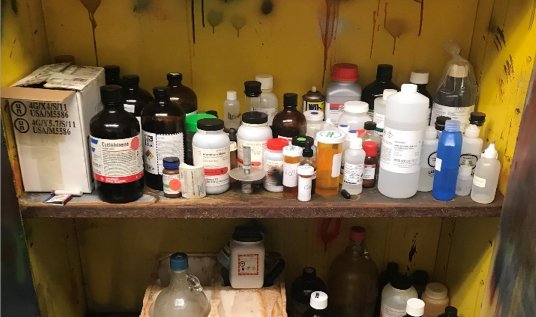School Leadership OSHA Science Safety Guidance
Flinn Staff Scientist
Educators have known Flinn as a ‘safer source of science’ for over 40 years. Flinn has been dedicating these resources to make school laboratories a safe environment for both students and instructors. Towards our contribution to creating a safe environment in our labs, in this post, we will be explaining the OSHA Lab Standard and how it applies to science & STEM teachers and everybody in the school ecosystem.
To ensure safety in your lab, you must organize your lab neatly. We found out that most labs and prep rooms in so many schools are not well organized and some even store all chemicals in one spot – alphabetically! That's the reason we need to address the OSHA Laboratory Standard.
OSHA Laboratory Standard ‘Occupational Exposure to Hazardous Chemicals in Laboratories Standard’ (29 CFR 1910.1450), referred to as the ‘Laboratory Standard’, covers laboratories where chemical manipulation generally involves small amounts of a limited variety of chemicals. This standard applies to all hazardous chemicals meeting the definition of “laboratory use” and having the potential for worker exposure. This means school laboratories and prep rooms—since January 1991.
The Key Points of the Laboratory Standard
Note that for you to carry out all the aspects of the Laboratory Standard, you must have a Chemical Hygiene Plan (CHP). It is a legal document that outlines the procedures in the laboratory area with an emphasis on the following:
- General laboratory rules and procedures
- Personal protective equipment requirements
- Accidental Spill and accident prevention procedures
- Chemical storage rules and procedures
- Safety equipment requirements and inspection procedures
- Employee safety training
- Exposure and medical evaluations
- Emergency evacuation plan
- Access to Information on SDS’s
- Labelling Requirements for chemicals under HAZCOM & OSHA RTK Laws.
If you want your CHP to be effective, you need to designate a Chemical Hygiene Officer to implement it. According to OSHA, the officer must be an employee of the school who is qualified either by training or experience to provide technical guidance in the development and implementation of the provisions of the Chemical Hygiene Plan.

Duties of a Chemical Hygiene Officer
- The officer should work with administrators and other employees to create and implement chemical hygiene policies and practices
- He/she needs to monitor the procurement, use and disposal of chemicals used in the lab.
- As a Chemical Hygiene Officer, you need to review all purchase orders that include chemical reagents & safety items and all lab procedures, including all new procedures to be introduced.
- It is your duty to ensure that staff training and facilities are adequate for materials ordered and all SDS forms are available and current; labels are GHS compliant.
- You should know the current legal requirements concerning regulated substances; (OSHA, NIOSH, NFPA, etc.)
There are more duties expected of you to keep the lab and its environment safe.
Basic Safety in the Lab
Basic safety is the foundation of a safe lab. Basic safety involves:
1) A functional PPE (Goggles/face shields/Hearing Protection/Respirator)
2) Engineering Controls (Fume Hood/Eyewash/Drench Shower/Chemical Safety Cabinets/Chemical Spill Kit)
3) Fire Safety (Extinguisher/Fire Blanket/Detector/Fire Alarm/Evacuation Procedure Signage)
4) Employee Training – Are your teachers trained in safety procedures & risk mitigation?

Conclusion
The OSHA Science Safety Guidance aims to ensure full-scale safety for everyone in the lab environment. It covers the laboratory rules, the provision of PPEs, chemical storage rules and so many other concepts. For a science lab to be safe, it needs an experienced instructor that will implement the standards and help drive a culture of safety awareness across the entire department.


